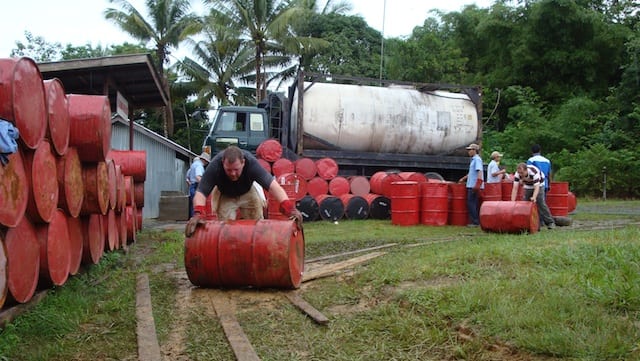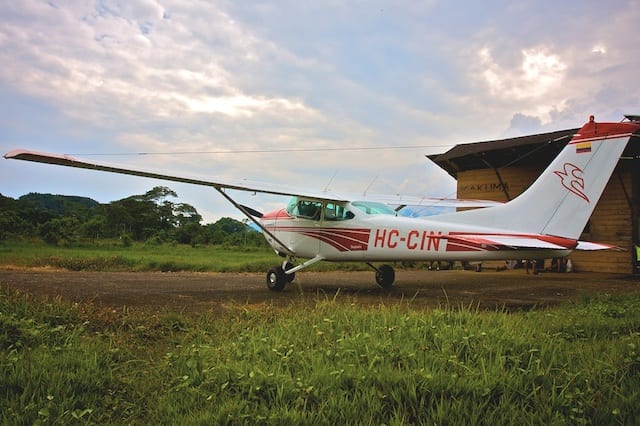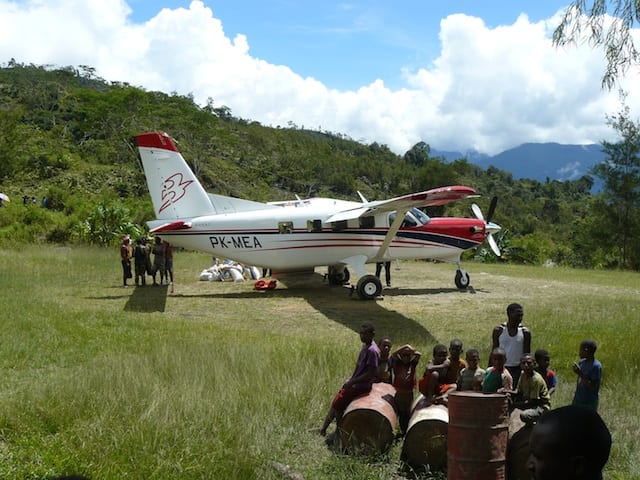By DIANNA GIBNEY
At $21 a gallon for avgas, many people would rethink their need to fly. That’s not an option for Mission Aviation Fellowship (MAF).
The Christian ministry organization operates a fleet of 136 airplanes in some of the most isolated places in the world, providing critical transportation in areas where few roads exist. Using short airstrips hacked out of jungles or carved into mountainsides, MAF pilots carry doctors, missionaries, relief workers, teachers and others to and from remote, primitive villages. They fly the sick or injured to medical care. They deliver food, water, and medical supplies in times of crisis.
“Across Africa, Indonesia, Asia and Latin America — in places isolated by terrain — MAF is desperately needed,” said John Boyd, MAF president and CEO. “If we don’t fly, it often means that people die.”
That’s why rising avgas prices have been such a concern for the 68-year-old organization. MAF has 52 Cessna 206s in its global fleet, which means the organization uses a lot of avgas. While the average price for a gallon of avgas hovers around $6 in the U.S., MAF often pays two or three times that overseas. In the Democratic Republic of the Congo (DRC) it’s currently $21 a gallon. And the fuel can be very difficult to obtain.
“The price never goes down, only up,” said Garth Pederson, MAF program manager in the DRC. “We have difficulty with avgas. At our current supplier their stock has run out-of-date. They say they have ordered more but that it likely won’t arrive for three months. Because of this we are unable to accept flights for the Cessna 206 apart from those previously scheduled, as we wait for more fuel.”
 “Since there isn’t a big demand for avgas here, there isn’t a huge incentive for suppliers to bring it in,” he continued. “We have imported our own stock before but the cost ended up being significantly higher than buying it from the local supplier and took over six months, plus required many different government licenses and permits at significant cost.”
“Since there isn’t a big demand for avgas here, there isn’t a huge incentive for suppliers to bring it in,” he continued. “We have imported our own stock before but the cost ended up being significantly higher than buying it from the local supplier and took over six months, plus required many different government licenses and permits at significant cost.”
In Mozambique, MAF is currently paying $11.88 per gallon for avgas, which is the lowest it has been since December 2012. According to Jill Holmes, who serves with MAF in Mozambique, “It’s not possible to obtain avgas in the city of Nampula where we operate. We generally try to purchase fuel from Pemba, about 250 miles away. When Pemba does not have fuel we order from Beira, which is a two-day drive one way. It’s 521 nautical miles between Beira and Pemba, the only two places in the northern half of Mozambique that sell avgas.”
Things are just as challenging in Indonesia, where MAF operates 22 aircraft at eight bases.
Steve Persenaire, manager of the MAF program in Kalimantan, Indonesia, says all avgas is imported by the Indonesian government, so MAF is at the mercy of import schedules.
“We can only buy avgas when Indonesia imports it,” he said, “so we have to sync our fuel orders with import shipments. In other words, if we order fuel and a shipment doesn’t come in for two or three months, we have to ration our remaining avgas until it arrives.”
As the fuel situation has become more challenging over the past two decades, MAF has not been idle. In places with more forgiving terrain that can accommodate larger aircraft, the organization uses Cessna 208s that burn Jet-A and can carry more passengers and cargo. Jet-A tends to be cheaper than avgas — sometimes half the price, sometimes even less — and is easy to obtain.
In Ecuador, where the fuel supply is controlled by the government and shortages occasionally occur, the MAF affiliate operates a Cessna 182 that burns auto fuel, allowing the ministry to ground its 206s when avgas supplies are low. But it’s small, and one 182 can’t do the work of the program’s four 206s.
 “It’s not as useful to us as the 206, but it works well for emergency medical evacuations where there’s just one patient and a companion,” said Dan Whitehead, MAF’s regional manager in Latin America. “And the 182 is of course cheaper to operate than the 206.”
“It’s not as useful to us as the 206, but it works well for emergency medical evacuations where there’s just one patient and a companion,” said Dan Whitehead, MAF’s regional manager in Latin America. “And the 182 is of course cheaper to operate than the 206.”
MAF has tried a similar tactic in the DRC, where the organization operates a Cessna 182 with an SMA diesel engine. This aircraft uses Jet-A, which currently costs $6 a gallon in Kinshasa and is always available.
“The SMA 182 aircraft has taken some of the work that the 206 used to do,” said Pederson, “but we pine for a diesel engine that would power the 206.”
Until that day arrives, the organization is pursuing a different tactic. In the mid-1990s, MAF and several other ministry groups joined with Quest Aircraft Co. to develop a brand-new airplane to meet the special needs of missionary aviation. The result: The Quest KODIAK.
The first KODIAK rolled off the assembly line in 2007. This turbine-engine STOL aircraft can serve many of the same remote airstrips where MAF’s 206s land, making it especially useful for reaching the isolated villages they serve. MAF now has six KODIAKs in Indonesia and two in Asia, and is excited about what the airplane can do.
 “I recently learned of a double medical evacuation flight that MAF performed in Kalimantan,” said Boyd. “A truck went over the edge of a mountain road and rolled 75 feet to the bottom of the ravine. Two badly injured men and their family members boarded the Kalimantan program’s KODIAK — the patients on blankets, strapped to the floor. A little over an hour later they were receiving lifesaving treatment in the city of Tarakan. This would have been impossible with the Cessna 206, which isn’t able to carry that much weight or that many people for such a distance. But the KODIAK can handle it.”
“I recently learned of a double medical evacuation flight that MAF performed in Kalimantan,” said Boyd. “A truck went over the edge of a mountain road and rolled 75 feet to the bottom of the ravine. Two badly injured men and their family members boarded the Kalimantan program’s KODIAK — the patients on blankets, strapped to the floor. A little over an hour later they were receiving lifesaving treatment in the city of Tarakan. This would have been impossible with the Cessna 206, which isn’t able to carry that much weight or that many people for such a distance. But the KODIAK can handle it.”
MAF hopes to add two more KODIAKs to its Indonesian fleet over the next year at a cost of some $1.7 million each. It is also raising funds to purchase a KODIAK for Ecuador, where its ability to fly over the Andes will allow MAF to expand its medical evacuation services in that country.
